

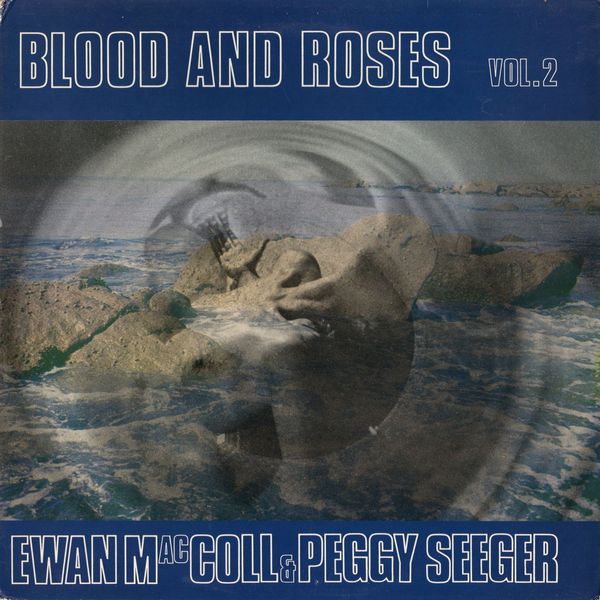 |
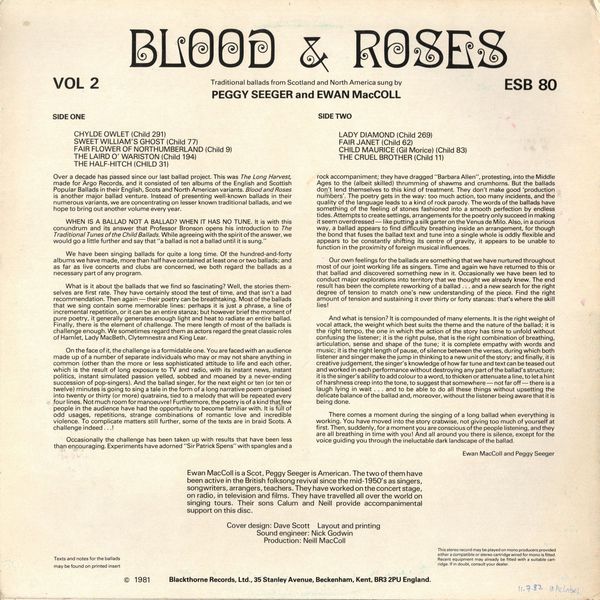
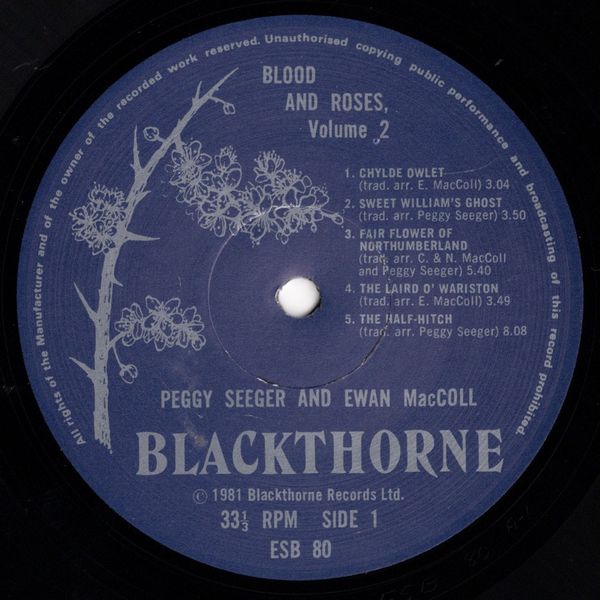
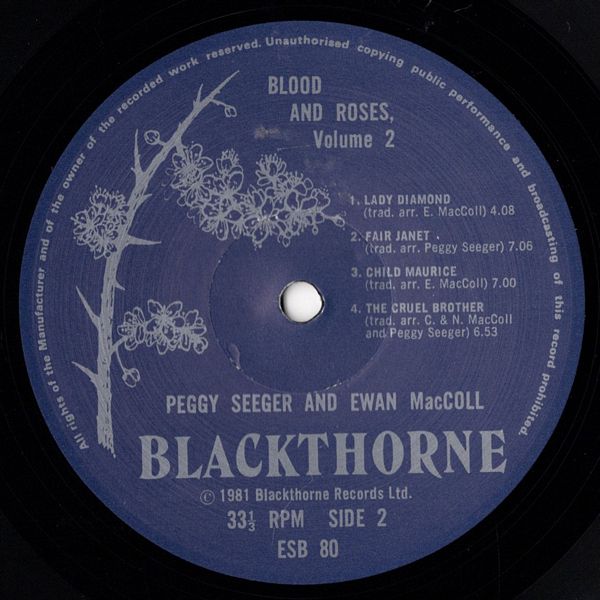
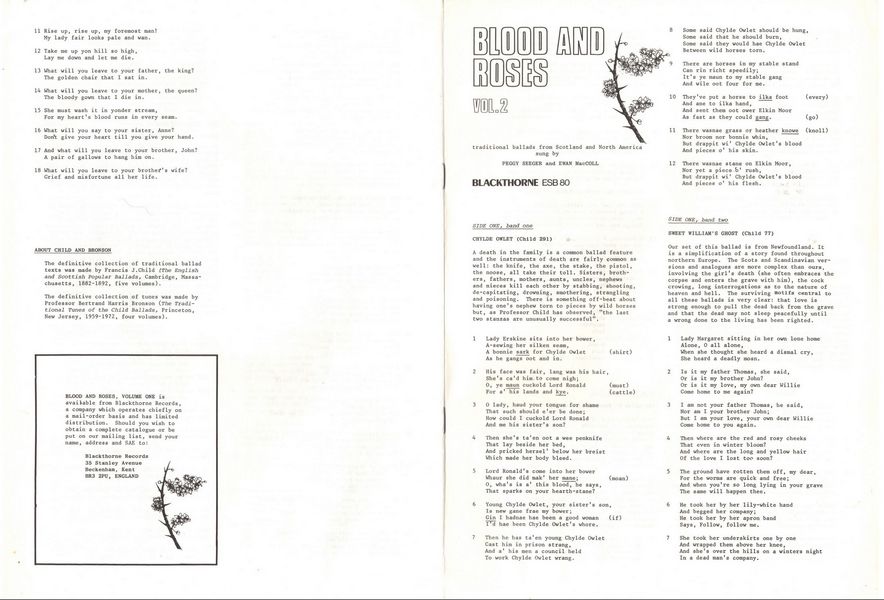 |
| more images |
Sleeve Notes
Traditional ballads from Scotland and North America sung by PEGGY SEEGER and EWAN MacCOLL
Over a decade has passed since our last ballad project. This was The Long Harvest, made for Argo Records, and it consisted of ten albums of the English and Scottish Popular Ballads in their English, Scots and North American variants. Blood and Roses is another major ballad venture. Instead of presenting well-known ballads in their numerous variants, we are concentrating on lesser known traditional ballads, and we hope to bring out another volume every year.
WHEN IS A BALLAD NOT A BALLAD? WHEN IT HAS NO TUNE. It is with this conundrum and its answer that Professor Bronson opens his introduction to The Traditional Tunes of the Child Ballads. While agreeing with the spirit of the answer, we would go a little further and say that "a ballad is not a ballad until it is sung."
We have been singing ballads for quite a long time. Of the hundred-and-forty albums we have made, more than half have contained at least one or two ballads; and as far as live concerts and clubs are concerned, we both regard the ballads as a necessary part of any program.
What is it about the ballads that we find so fascinating? Well, the stories them-selves are first rate. They have certainly stood the test of time, and that isn't a bad recommendation. Then again — their poetry can be breathtaking. Most of the ballads that we sing contain some memorable lines: perhaps it is just a phrase, a line of incremental repetition, or it can be an entire stanza; but however brief the moment of pure poetry, it generally generates enough light and heat to radiate an entire ballad. Finally, there is the element of challenge. The mere length of most of the ballads is challenge enough. We sometimes regard them as actors regard the great classic roles of Hamlet, Lady MacBeth, Clytemnestra and King Lear.
On the face of it, the challenge is a formidable one. You are faced with an audience made up of a number of separate individuals who may or may not share anything in common (other than the more or less sophisticated attitude to life and each other, which is the result of long exposure to TV and radio, with its instant news, instant politics, instant simulated passion yelled, sobbed and moaned by a never-ending succession of pop-singers). And the ballad singer, for the next eight or ten (or ten or twelve) minutes is going to sing a tale in the form of a long narrative poem organised into twenty or thirty (or more) quatrains, tied to a melody that will be repeated every four lines. Not much room for manoeuvre! Furthermore, the poetry is of a kind that few people in the audience have had the opportunity to become familiar with. It is full of odd usages, repetitions, strange combinations of romantic love and incredible violence. To complicate matters still further, some of the texts are in braid Scots. A challenge indeed …!
Occasionally the challenge has been taken up with results that have been less than encouraging. Experiments have adorned "Sir Patrick Spens" with spangles and a rock accompaniment; they have dragged "Barbara Allen", protesting, into the Middle Ages to the (albeit skilled) thrumming of shawms and crumhorns. But the ballads don't lend themselves to this kind of treatment. They don't make good 'production numbers'. The poetry gets in the way: too much action, too many incidents, and the quality of the language leads to a kind of rock parody. The words of the ballads have something of the feeling of stones fashioned into a smooth perfection by endless tides. Attempts to create settings, arrangements for the poetry only succeed in making it seem overdressed — like putting a silk garter on the Venus de Milo. Also, in a curious way, a ballad appears to find difficulty breathing inside an arrangement, for though the bond that fuses the ballad text and tune into a single whole is oddly flexible and appears to be constantly shifting its centre of gravity, it appears to be unable to function in the proximity of foreign musical influences.
Our own feelings for the ballads are something that we have nurtured throughout most of our joint working life as singers. Time and again we have returned to this or that ballad and discovered something new in it. Occasionally we have been led to conduct major explorations into territory that we thought we already knew. The end result has been the complete reworking of a ballad … and a new search for the right degree of tension to match one's new understanding of the piece. Find the right amount of tension and sustaining it over thirty or forty stanzas: that's where the skill lies!
And what is tension? It is compounded of many elements. It is the right weight of vocal attack, the weight which best suits the theme and the nature of the ballad; it is the right tempo, the one in which the action of the story has time to unfold without confusing the listener; it is the right pulse, that is the right combination of breathing, articulation, sense and shape of the tune; it is complete empathy with words and music; it is the right length of pause, of silence between the verses, during which both listener and singer make the jump in thinking to a new unit of the story; and finally, it is creative judgment, the singer's knowledge of how far tune and text can be teased out and worked in each performance without destroying any part of the ballad's structure; it is the singer's ability to add colour to a word, to thicken or attenuate a line, to let a hint of harshness creep into the tone, to suggest that somewhere — not far off— there is a laugh lying in wait … and to be able to do all these things without upsetting the delicate balance of the ballad and, moreover, without the listener being aware that it is being done.
There comes a moment during the singing of a long ballad when everything is working. You have moved into the story crabwise, not giving too much of yourself at first. Then, suddenly, for a moment you are conscious of the people listening, and they are all breathing in time with you! And all around you there is silence, except for the voice guiding you through the ineluctable dark landscape of the ballad.
Ewan MacColl and Peggy Seeger
Ewan MacColl is a Scot, Peggy Seeger is American. The two of them have been active in the British folksong revial since the mid-1950's as singers, songwriters, arrangers, teachers. They have worked on the concert stage, on radio, in television and films. They have travelled all over the world on singing tours. Their sons Calum and Neill provide accompanimental support on this disc.
Chylde Owlet (Child 291) — A death in the family is a common ballad feature and the instruments of death are fairly common as well: the knife, the axe, the stake, the pistol, the noose, all take their toll. Sisters, brothers, fathers, mothers, aunts, uncles, nephews and nieces kill each other by stabbing, shooting, de-capitating, drowning, smothering, strangling and poisoning. There is something off-beat about having one's nephew torn to pieces by wild horses but, as Professor Child has observed, "the last two stanzas are unusually successful".
Sweet William's Ghost (Child 77) — Our set of this ballad is from Newfoundland. It is a simplification of a story found throughout northern Europe. The Scots and Scandinavian versions and analogues are more complex than ours, involving the girl's death (she often embraces the corpse and enters the grave with him), the cock crowing, long interrogations as to the nature of heaven and hell. The surviving motifs central to all these ballads is very clear: that love is strong enough to pull the dead back from the grave and that the dead may not sleep peacefully until a wrong done to the living has been righted.
The Fair Flower Of Northumberland (Child 9) — The earliest text of this popular ballad is to be found under the title of "The Maiden's Song" in Deloney's The Pleasant Historie of John Winchcomb, in his younger years called Jack of Newberie. Thomas Deloney, the balleting silk weaver of Norwich, entered Jack of Newberie in the Stations Register on March 7, 1596-7. He has "The Maiden's Song" sung by women cardroom workers "who for the most part were very faire and comely creatures and were all attired alike from top to toe. Then (after due reverence) the maidens in dulcet manner chaunted out this song, two of them singing the Ditty and all the rest bearing the burden."
(accompaniment: Calum, psaltery; Neill, guitar; Peggy, Appalachian dulcimer)
The Laird O' Wariston (Child 194) — Jean Livingstone of Dunnipace and John Kincaid of Wariston, the two main protagonists in this prosaic domestic tragedy, were (according to contemporary accounts) married against their will at a very early age. Kincaid's consistent ill-treatment of his young wife eventually caused her to murder him. Janet Murdo, her nurse, and Robert Weir, a former servant in her father's house, helped her to carry out the deed.
No attempt was made to cover up the crime and within three days of having committed it Jean Livingstone was tried, found guilty and condemned to death. She was beheaded at the Canongate in Edinburgh on July 5, 1600 and Janet Murdo was burned at the stake on the same day. Robert Weir fled but was apprehended four years later and was executed by having his body broken on a cartwheel by the coulter of a plough.
The Half-Hitch (Child 31) — Child gives the title of this ballad as "The Marriage of Sir Gawain", but the poetry of his sets has little in common with that of "The Half-Hitch", or "The Loathly Bride" as it is sometimes called. The themes, on the other hand, are consistent right back through a whole series of songs and stories from the Middle Ages: that a vow once given must be kept, and that a courteous knight is wed (by his vow) to a repulsive bride. The use of the cante-fable form (not mentioned in Child) adds to the local humour of our set, which comes from Maine.
(accompaniment: Peggy, on guitar)
Lady Diamond (Child 269) — The English and Scots repertories of traditional songs and ballads contain innumerable stories of star-crossed lovers and the punishments awaiting those ill-fated innocents who find themselves caught in the web of a misalliance. In this ballad, the base-born lover is guilty of the crime of lese-majesty, and the traditional punishment for violating this particular tabu is by smothering. "The ballad is one of a large number of repetitions of Boccaccio's tale of "Guiscardo and Ghismonda,"Decameron IV, 1. It was translated in Painter's Palace of Pleasure, 1566 and became the foundation of various English poems and plays." (Child)
Fair Janet (Child 64) — Throughout balladry, the women are challenging the right of their fathers and brothers to dispose of their hands in marriage. No reason is given in "Fair Janet" for Willie's ineligibility as a bride-groom though it is suggested that he is not high-born enough. It is a brutal ballad in its earlier forms, in which Janet dances to prove that she has not born a child, that she is physically fit. The ballad shares many motifs with N. European song and tale, but seems to have practically died out in oral tradition.
Child Maurice (Gil Morice) (Child 83) — The earliest printed copies of "Child Maurice" belong to the mid-1700's, though it was probably in oral circulation at an earlier date. It provided the basis for Home's tragedy The Douglas, produced in Edinburgh in 1756 and, in its turn, the play seems to have created a vogue for the ballad. The version given here is a more recent and — dare we say it? — superior composition.
In our ballad the argument between Gil Morice and his footpage has been developed in such a way as to give an extra dimension to the ballad. The footpage has ceased to be a mere lay figure; he is now a fully filled-out character, a hot-tempered young man whose advice has been ignored and whose loyalty to his master has been turned into flaming resentment. In other ways too, the ballad is a rewarding one, full of incident, interesting dialogue and memorable lines of poetry, as "I aince was fu' o' Gil Morice as hip is o' the stane": surely one of the most potent metaphors for pregnancy in all literature.
The Cruel Brother (Child 11) — In 1858, according to Aytoun, the Scots collector, this was "the most popular of the Scottish ballads". In 1846, it was common amongst English rural folk. Bronson reckons that it had disappeared from Britain by the turn of this century, but turns up — albeit rarely — in the United States. Most of the American sets are from the South, although ours is from Vermont.
At first glance, the motive for the murder seems to be incest. Several other incest ballads ("Edward" and "Lizie Wan") have testament verses such as our stanzas 13-18. Scholars tend to dismiss this motive in favour of another social phenomenon, one set in a vestigially matriarchal society. Child puts it: The offence given by not asking a brother's assent to his sister's marriage was in ballad-times regarded as an unpardonable offence." This could be due to the fact that a brother's duty to his sister's offspring (and vice-versa, as in "Chylde Owlet") was of prime importance — therefore his consent was required. Fraser, in The Golden Bough, takes us even further back into societies in which sisters were the heirs rather than brothers, and many brothers married their sisters rather than lost the parental inheritance.
(accompaniment: Calum, Appalachian dulcimer; Peggy, 5-string banjo)